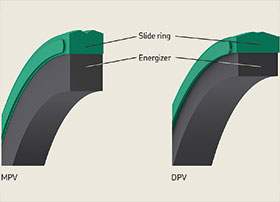

The development of a range of class-leading hydraulic piston seals required SKF engineers to create tailor-made materials and apply advanced analytical techniques.
The piston seal lies right at the heart of hydraulic cylinder performance. Located in a groove on the outer diameter of the piston, this seal must contain the high pressure hydraulic fluid without impeding the motion of piston along the length of the cylinder. Since most hydraulic cylinders operate bi-directionally, the seal must be able to handle pressure from either side. The design of piston seals requires engineers to tread a fine line between friction and sealing performance. If the seal allows too much fluid to leak from the high pressure side of the cylinder to the low pressure side, performance is compromised. On the other hand, excessive friction on the cylinder wall leads to accelerated wear and a reduced operating life. Outright failure of a piston seal, known as blow-by, can have significant operational and safety implications, potentially causing construction or materials handling equipment to lose control of its load, for example.
If the basic operating requirements weren’t demanding enough, piston seals also present a significant materials engineering challenge, with hydraulic fluids at high temperatures and pressures that are tough on sealing materials and which can cause other components to expand and contract during operation.
It was a quest to overcome the disadvantages of PTFE seals that led a team of engineers at SKF to attempt the development of an alternative sealing technology, based on the company’s well-established Ecopur polyurethane material.
“Constructing a polyurethane seal that could match the performance of the best PTFE seals was far from straightforward,” explains Wolfgang Swete, head of R&D for the fluid seals strategic product line. “The large extrusion gap between the piston and cylinder wall means you need a material with sufficient extrusion resistance to hold its shape under the full range of operating conditions.” The company took advantage of its in-house material development and manufacturing capabilities to produce a special grade of Ecopur specifically for the piston seal application.
With a suitable material in place, the SKF team then had to create the right sealing geometry. This was familiar territory for the company’s engineers, who have a well-established product development process that combines extensive computer simulation using finite element techniques, rapid prototype development using CNC machine tools and physical testing on custom-made static and dynamic test equipment.
In the final design, the geometry of the outer surface of the polyurethane slide ring has a shallow ‘M’ shape with two carefully optimised sealing lips. “A seal profile with pronounced sealing points provides more effective sealing forces than a flat surface, improving seal performance while reducing the amount of frictional drag that is created by the seal, says Swete. “And concentrating the forces on two sealing edges rather than one means the seal won’t tilt in use, which can lead to early failure.”
In the new SKF design, side vents are incorporated into the radial side walls of the slide ring to ensure pressure activation of the energiser. This enables the seal to rapidly shift position as the direction of pressure changes, reduce the potential for blow-by and loss of cylinder functionality. The side vents also reduce the likelihood of a pressure trap occurring when the slide ring seals against the radial walls of the seal gland, which can also result in the loss of cylinder functionality.
To validate the designs, prototype seals underwent further arduous testing involving more than 200 km of movement up and down a 400 mm test cylinder at pressures of up to 250 bar and temperatures of 80°C. Friction and leakage were measured during the test, and after the tests, seals were measured and examined to check extrusion and surface wear.
SKF has now developed its innovative piston seal design into a full offering for a broad range of hydraulic applications. The light duty LPV range with an O-ring actuator is aimed at indoor, stationary applications, like manufacturing machinery. The seals are suitable for pressures of up to 250 bar, speeds of up to 0,5 m/s and temperatures of between -20 and 100°C. The medium to heavy duty MPV range is aimed at more demanding applications such as those found in mobile agricultural and construction machinery. Sized to fit into metric-sized housings, MPV seals are suitable for pressures of up to 400 bar, speeds of up to 1 m/s and temperatures of -20 to 110°C.
For more information contact Samantha Joubert, SKF South Africa, +27 11 821 3500, [email protected], www.skf.com
| Tel: | +27 11 821 3500 |
| Fax: | +27 11 821 3501 |
| Email: | [email protected] |
| www: | www.skf.co.za |
| Articles: | More information and articles about SKF South Africa |

© Technews Publishing (Pty) Ltd | All Rights Reserved